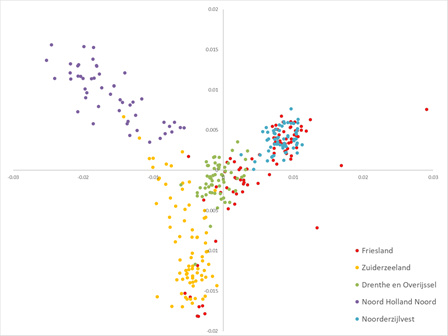One of the components of the Life MICA project is a study into the interrelationship of muskrats. This allows migration routes to be determined. In the period February 2020 – February 2021, muskrat trappers in the Netherlands, Belgium and Germany collected tail tips from muskrats for this research.
Central to the research is the muskrat population in the province of Friesland. Samples were collected in Friesland and in a surrounding area. As a reference, samples were also collected in Germany (Vechte), Flanders, Rivierenland and Tiengemeten.
Research questions
Three research questions have been formulated for the study:
- Can source areas be recognized through a difference in DNA profile?
- Is there reproduction within Friesland?
- Is there immigration from surrounding regions?
Source areas and Friesland

The results of the DNA analysis are plotted in the graph above. Each color represents a trapping organization. Red dots between yellow dots means that the muskrats trapped in Friesland show a strong relationship with the population in Zuiderzeeland, and especially the Noordoostpolder. The 3 free red dots on the right side represent the ‘own’ Frisian population.
Origin of muskrats trapped in Friesland

3% of the muskrats sampled come from the presumably ‘own’ population of Friesland. The distribution of the origin of the other sampled muskrats is:
- 58% Noorderzijlvest
- 26% WDO Delta
- 13% Zuiderzeeland
The answers to the questions:
- Can source areas be recognized through a difference in DNA profile?
Yes, the DNA method used can be used to tell the different source areas apart. - Is there reproduction within Friesland?
Yes, some animals have been found from the (presumably) original muskrat population in Friesland. - Is there immigration from surrounding regions?
Yes, except from North Holland, muskrats have been found from all surrounding areas.
What’s next?
Based on the results, the trap intensity along the probable inflow locations in Friesland will be increased by placing a cordon of traps here. In addition, in the period from February 2022 – February 2023, the tail tips of all muskrats trapped in Friesland will be collected for follow-up research.
